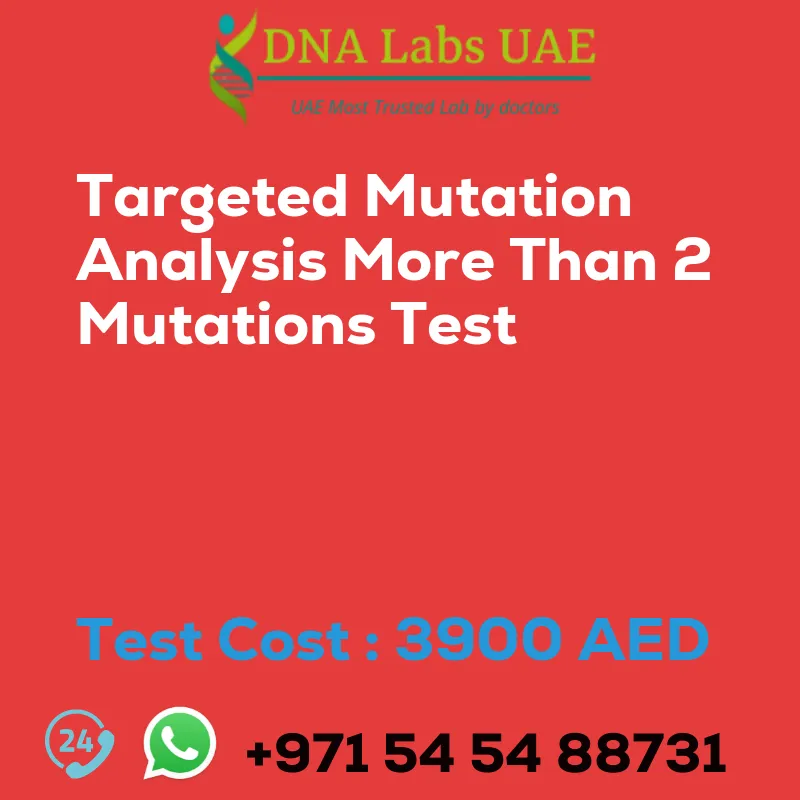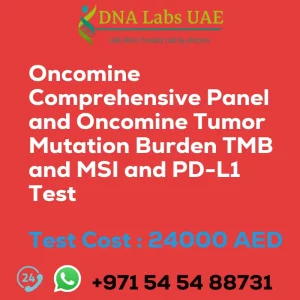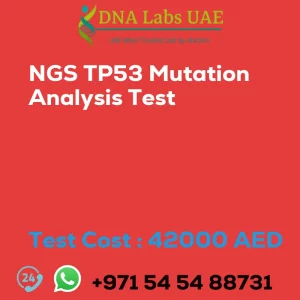Targeted Mutation Analysis more than 2 Mutations Test
Test Cost: AED 3900.0
Symptoms and Diagnosis
If you suspect the presence of multiple mutations in a specific gene or genomic region, the targeted mutation analysis can help in identifying and analyzing these mutations. This test is commonly used in genetics and can provide valuable insights into the genetic variations present.
Test Components
- EDTA Vacutainer (2ml)/ Sterile Container
Sample Condition
The test can be performed on the following sample types:
- Peripheral blood
- Plasma
- Serum
- Amniotic fluid
- Cord Blood
- Chorionic villi
Report Delivery
The test results will be delivered within 10-15 days after sample submission.
Method
The targeted mutation analysis is performed using the Sanger sequencing method, which is a widely used technique in genetics.
Test Type
This test falls under the category of genetics.
Doctor
A gynecologist can prescribe this test.
Test Department
This test is conducted in the genetics department of the DNA Labs UAE.
Pre Test Information
Targeted mutation analysis (more than 2 mutations) can be done with a doctor’s prescription. However, please note that the prescription is not applicable for surgery and pregnancy cases or individuals planning to travel abroad.
Test Details
Targeted mutation analysis refers to the process of specifically identifying and analyzing mutations in a targeted region of the genome. This can involve the identification of single mutations or multiple mutations in a specific gene or genomic region.
When it comes to analyzing more than two mutations, the process becomes more complex. Here are the key steps involved:
- Target selection: Identify the specific gene or genomic region of interest where the mutations are suspected to be present. This can be based on previous knowledge or specific research questions.
- Sample collection: Obtain samples containing the DNA of interest, such as blood, tissue, or cells. These samples can be from individuals or experimental models.
- DNA extraction: Isolate the DNA from the collected samples using standard techniques. This ensures that the DNA is pure and suitable for subsequent analysis.
- Mutation detection: Use appropriate molecular techniques to detect and identify mutations in the targeted region. This can include PCR (polymerase chain reaction), DNA sequencing, or other methods such as Sanger sequencing or next-generation sequencing (NGS).
- Data analysis: Analyze the obtained sequencing data to identify and characterize the mutations present in the targeted region. This can involve comparing the obtained sequences with a reference sequence or using bioinformatics tools to identify specific mutations.
- Validation: Validate the identified mutations using additional techniques, such as allele-specific PCR or functional assays, to confirm their presence and functional impact.
- Interpretation: Analyze and interpret the results to understand the potential implications of the identified mutations. This can involve considering the known function of the gene or genomic region, previous research findings, and clinical relevance.
It is important to note that targeted mutation analysis for multiple mutations can be time-consuming and technically challenging. It requires expertise in molecular biology techniques, bioinformatics, and genetic analysis. Additionally, the interpretation of the results may require collaboration with experts in the field, such as geneticists or clinicians, to understand the clinical significance of the identified mutations.
| Test Name | Targeted mutation Analysis more than 2 mutations Test |
|---|---|
| Components | EDTA Vacutainer (2ml)/ Sterile Container |
| Price | 3900.0 AED |
| Sample Condition | Peripheral blood\/ Plasma\/ Serum\/ Amniotic fluid \/ Cord Blood\/Chorionic villi |
| Report Delivery | 10-15 days |
| Method | Sanger Sequencing |
| Test type | Genetics |
| Doctor | Gynecologist |
| Test Department: | |
| Pre Test Information | Targeted mutation Analysis (more than 2 mutations) can be done with a Doctors prescription. Prescription is not applicable for surgery and pregnancy cases or people planing to travel abroad. |
| Test Details | Targeted mutation analysis refers to the process of specifically identifying and analyzing mutations in a targeted region of the genome. This can involve the identification of single mutations or multiple mutations in a specific gene or genomic region. When it comes to analyzing more than two mutations, the process becomes more complex. Here are some key steps involved in targeted mutation analysis for multiple mutations: 1. Target selection: Identify the specific gene or genomic region of interest where the mutations are suspected to be present. This can be based on previous knowledge or specific research questions. 2. Sample collection: Obtain samples containing the DNA of interest, such as blood, tissue, or cells. These samples can be from individuals or experimental models. 3. DNA extraction: Isolate the DNA from the collected samples using standard techniques. This ensures that the DNA is pure and suitable for subsequent analysis. 4. Mutation detection: Use appropriate molecular techniques to detect and identify mutations in the targeted region. This can include PCR (polymerase chain reaction), DNA sequencing, or other methods such as Sanger sequencing or next-generation sequencing (NGS). 5. Data analysis: Analyze the obtained sequencing data to identify and characterize the mutations present in the targeted region. This can involve comparing the obtained sequences with a reference sequence or using bioinformatics tools to identify specific mutations. 6. Validation: Validate the identified mutations using additional techniques, such as allele-specific PCR or functional assays, to confirm their presence and functional impact. 7. Interpretation: Analyze and interpret the results to understand the potential implications of the identified mutations. This can involve considering the known function of the gene or genomic region, previous research findings, and clinical relevance. It is important to note that targeted mutation analysis for multiple mutations can be time-consuming and technically challenging. It requires expertise in molecular biology techniques, bioinformatics, and genetic analysis. Additionally, the interpretation of the results may require collaboration with experts in the field, such as geneticists or clinicians, to understand the clinical significance of the identified mutations. |







